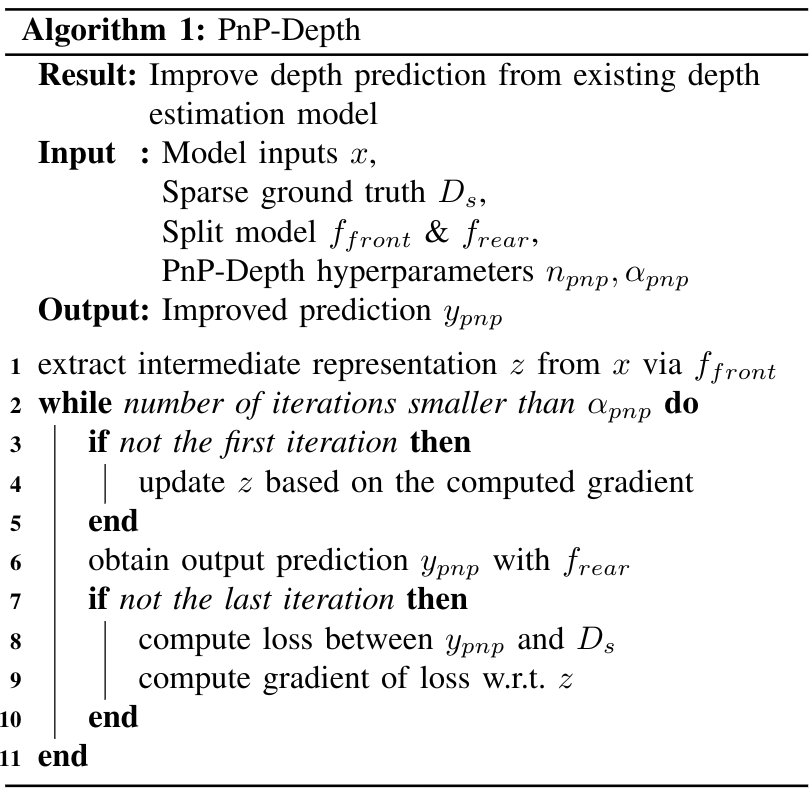project page | paper | video
Implementation for "Plug-and-Play: Improve Depth Prediction via Sparse Data Propagation", ICRA 2019. PnP-Depth is used as an add-on module to existing depth completion models. Only with a few line of modification on the original code, we can apply PnP-Depth to the model and obatin performance gain.
The above figure shows the improvement of depth estimation (red regions in the bottom-right figure) by propagating and exploiting information of sparse depth (upper-right) using our PnP-Depth module.
You can try PnP-Depth out if you are using your whatever estimation/prediction model under the following conditions:
- you are predicting or estimating whatever given partial or sparse ground truth.
- your model is differentiable, e.g. a deep network.
After applying PnP-Depth, you can:
- get better performance/accuracy on the prediction,
- but in the sacrifice of inference time.
We first split the original model f to two parts, f_front and f_rear, such that f(x) = f_rear(f_front(x)). Given sparse ground truth D_s, our PnP-Depth iteratively updates the intermediate representation z based on the gradient computed from sparse points and re-inference to obtain better depth prediction. Here, we illustrate an example for two iterations.
Here we show the pseudocode of PnP-Depth.
Here we show some examples of applying PnP-Depth to existing models.
- PnP-Depth in Pytorch. There is an example of applying PnP-Depth to a depth completion model originated from here. The modified code is shown in sparse-to-dense.pytorch. We only add a few lines to model.py and replace main.py with main_pnp.py (new main file is created solely for clarity). Search for
PnP-Depthin the files to find all modification. A quick glance at PnP-Depth in Pytorch:
import torch
from torch.autograd import Variable
from torch.autograd import grad as Grad
# Original inference
z = model.forward_front(inputs)
ori_pred = model.forward_rear(z)
# Inference with PnP
n_iters = 5 # number of iterations
alpha = 0.01 # update rate
z = model.forward_front(inputs)
for i in range(n_iters):
if i != 0:
z = z - alpha * torch.sign(z_grad) # iterative Fast Gradient Sign Method
z = Variable(z, requires_grad=True)
pred = model.forward_rear(z)
if i < n_iters - 1:
loss = criterion(pred, sparse_depth) # "sparse_depth" can be replaced with any partial ground truth
z_grad = Grad([loss], [z], create_graph=True)[0]
# "pred" is the prediction after PnP module
- PnP-Depth in Tensorflow. We utilize this depth completion code as an illustration. The modifications are in sparse_cnn.py and admm.py. Also, main.py is replaced with main_pnp.py (new main file is created solely for clarity). Search for
PnP-Depthin the files to find all modification. A quick glance at PnP-Depth in Tensorflow:
import tensorflow as tf
def model_front(x):
... # whatever definition for your model here
def model_rear(z, reuse=False):
with tf.variable_scope('', reuse=reuse):
... # whatever definition for your model here
# Original inference
z = model_front(inputs)
ori_pred = model_rear(z)
# Inference with PnP
n_iters = 5 # number of iterations
alpha = 0.01 # update rate
def _cond(z_loop, i_loop):
return tf.less(i_loop, n_iters)
def _body(z_loop, i_loop):
pred_loop = model_rear(z)
loss_loop = criterion(pred_loop, sparse_depth) # "sparse_depth" can be replaced with any partial ground truth
z_grad_loop = tf.gradients(loss_loop, z_loop)
z_loop = tf.stop_gradients(z_loop - alpha * tf.sign(z_grad_loop))
return z_loop, i_loop + 1
z = model_front(inputs)
z, _ = tf.while_loop(_cond, _body, (z, 0), back_prop=False, name='pnp')
pred = model_rear(z, True)
# "pred" is the prediction after PnP module
While applying PnP-Depth to your model, you need to decide which layer's feature to be the intermediate representation z. The following shows how to do so:
- Choosing z further from the output layer yields better performance gain since it produces a larger influential field.
- Whereas choosing z closer to the output layer yields few improvement but brings less overhead on inference time.
- Do NOT run too many iterations (
alphain the code) since the information of sparse points will be exploited and the improvements will saturate. - More detailed analysis is shown in the paper.
@article{wang2018plug,
title={Plug-and-Play: Improve Depth Estimation via Sparse Data Propagation},
author={Wang, Tsun-Hsuan and Wang, Fu-En and Lin, Juan-Ting and Tsai, Yi-Hsuan and Chiu, Wei-Chen and Sun, Min},
journal={arXiv preprint arXiv:1812.08350},
year={2018}
}


